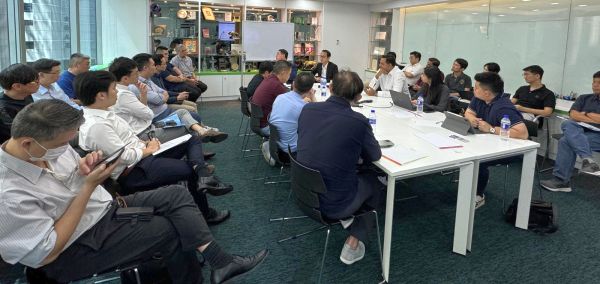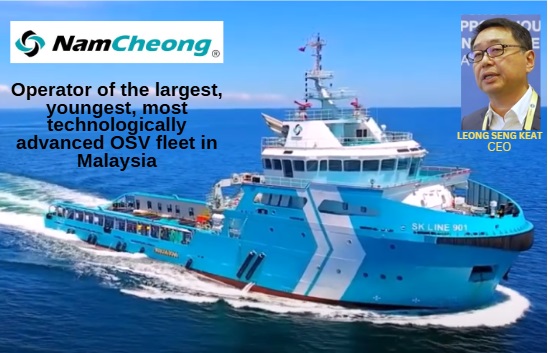|
This company is what DBS Group Research, in its 17 Nov 2025 initiation report, calls an "undervalued gem". The Singapore-listed company is a major player in the business of Offshore Support Vessels (OSVs). |
 Ho Pei Hwa, analystNow, why is DBS Group Research highlighting that the "tide is turning" for Nam Cheong (whose share price is +110% year to date but whose PE ratio is substantially lower than some peers like Marco Polo Marine)?
Ho Pei Hwa, analystNow, why is DBS Group Research highlighting that the "tide is turning" for Nam Cheong (whose share price is +110% year to date but whose PE ratio is substantially lower than some peers like Marco Polo Marine)?
The report authored by veteran analyst Ho Pei Hwa gives two key reasons:
| I. Stronger Earnings Visibility and Growth: Anchoring in Long-Term Stability |
The report outlines a clear path for future profits and profit growth.
Step 1: The Shift to Long-Term Contracts
Nam Cheong has made a strategic shift to secure long-term charters—contracts that last two to three years.
|
NAM CHEONG |
|
|
Share price: |
Target: |
Management is aiming for 70% of the fleet to be under these steady contracts, and it is already well over 60%.
As of mid-2025, the orderbook stood at RM1.7 billion (about SGD535 million), which is enough to cover revenue for over two years.
Step 2: Boosting Fleet Utilisation
Earlier this year, Nam Cheong's fleet utilisation was lower than normal because the vessels were taking downtime to get ready for those new long-term contracts.
We are now seeing a sequential rebound in activity, with utilisation expected to normalize and reach around 70% in 2026, up from about 60% earlier.
Step 3: Expanding the Fleet
Nam Cheong is expanding its fleet by adding new Geotech subsea vessels and Fast Crew Boats (FCBs), bringing the total fleet size up to 41 vessels by the end of 2025.
These Geotech vessels are crucial for work like pipe-laying and installing subsea cables, and they command solid day rates, which is expected to drive 6-8% of the company's revenue growth in 2026.
DBS Research says all of this together—the secure contracts, the jump in utilisation, and the new vessel additions—is expected to drive double-digit growth of 11% to 13% in revenue and net profit for 2026.
Plus, they are growing beyond their main customer, Petronas, by diversifying into buoyant markets like the Middle East. That’s a solid roadmap for growth.
| II. Revival of OSV Newbuild Orders for Nam Cheong's Shipyard |
The first part of the Nam Cheong story is about running its young fleet.
The second part is about its shipbuilding heritage and a huge opportunity waiting right around the corner.
The Problem: An Ageing Fleet
Malaysia's national oil company, Petronas, has raised a major concern: the country's OSV fleet is getting old.
Data shows that 80% of Malaysian vessels will be older than 12 years, and a significant chunk of them are nearing the 20-year age ceiling that Petronas sets for its tender requirements.
Simply put, these ships are becoming obsolete, and the industry urgently needs to be refreshed.
The Solution: The Safina Programme
To tackle this, Petronas launched the Safina newbuild programme.
This is a massive initiative that aims to replace old tonnage by getting up to 100 domestically built OSVs delivered over four to five years.
But there have been delays in Phase 2 due to factors like higher prices and financing difficulties, but the need for new, modern, and fuel-efficient ships cannot go away. Nam Cheong's investor briefing post-debt restructuring. File photo.
Nam Cheong's investor briefing post-debt restructuring. File photo.
Nam Cheong's Miri Shipyard
Before facing a multi-year downturn, Nam Cheong was a leading OSV builder. It owns the 12.6-hectare Miri shipyard in Sarawak, which has the capacity to construct up to 12 vessels annually.
This shipyard is perfectly poised to be the prime beneficiary of the newbuild revival.
The shipyard could start generating significant profits. DBS Research's estimates are huge: as newbuild demand returns, Nam Cheong could generate net profits from the shipyard ranging from RM20 million (with just four deliveries) all the way up to over RM180 million (at peak capacity).
This potential income from the shipyard—the "newbuild" money—is currently not factored into the company’s current valuation. This potential alone could add an incremental fair value of SGD0.13 to SGD1.15 per share, says DBS Group Research.
Post-debt restructuring in early 2024, Nam Cheong is not just surviving; it’s setting sail for a new growth cycle.
With earnings stability locked in by long-term charters and a massive, unpriced opportunity waiting at the Miri shipyard, this is a story DBS Group Research says is worth watching, calling Nam Cheong a multi-bagger in the making.
"Nam Cheong is trading at only ~5x FY26 PE, an unwarranted, steep discount of 50%-60% to closest peers such as Singapore-based Macro Polo (12x PE), Pacific Radiance (8x), and Malaysia-based Lianson (24x).
"We believe Nam Cheong’s fair value should be SGD1.25, based on 8x FY26 PE. "This does not reflect the potential valuation of its Miri Shipyard, which could add SGD0.13-1.15/share when OSV newbuilds make a comeback." -- DBS Group Research |









